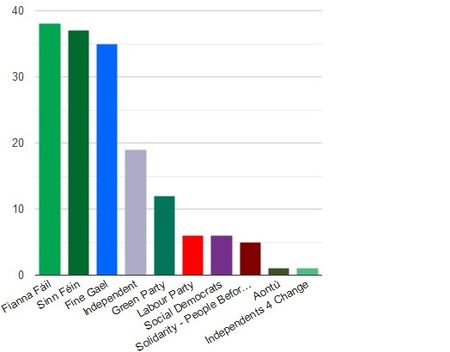More than 128 days after February’s general election, and against the backdrop of ‘lock down’, it would appear that Ireland has a new government. This new government, if endorsed by the members of the three parties involved, is of significance for a number of reasons. A report by Darragh Golden.
To read the article in Czech, click here (casopisargument.cz, media partner of transform! europe)
For starters, it will be the first time that the two so-called ‘civil war’ parties, Fianna Fáil (European affiliation: Renew Europe Group, liberal) and Fine Gael (EPP, conservative), put their ‘differences’ aside and form a coalition government. This has only taken them the best part of a century and is indicative of the transformative nature that the Eurocrisis and austerity has had on the Irish political landscape. Such an outcome would have been unimaginable even ten years earlier. It was on the cards at the last election, but Fianna Fáil could not abandon ‘civil war’ politics, for fear of Sinn Féin (GUE/NGL, left-wing) becoming the main party of opposition, and instead entered a ‘confidence and supply’ agreement with the Fine Gael-led government. Both parties paid the price for this approach at the recent election and Sinn Féin was the (unexpected) clear winner, however, the leftist party did not field enough candidates to capitalise on the mistakes of Fianna Fáil and Fine Gael. Especially in electoral politics hindsight is 2020 vision.
Results 2020 Irish General Election

Turnout: 62.9%
Source: IrelandElection.com
The terrible twins
The mood music following the election was one of change, although what form that change will take is still emerging. Centre-right politics have always dominated Irish politics and here there is no change. Since 1932 Fianna Fáil has had a veritable political hegemony, which was punctuated by single term Fine Gael governments. The onset of the economic crisis in 2008 was correctly blamed on the neoliberal policies of Fianna Fáil and its reluctance to address a growing housing bubble. The electorate punished the party in 2011, its worst election ever. Fine Gael took the reins and in 2016, for the first time in its history, won a second election, albeit barely. For decades now commentators and other political parties have argued that there is no difference between Fianna Fáil and Fine Gael in terms of policy. The typical soundbite is that you could not fit a cigarette paper between them! Once Sinn Féin was permitted to participate in the televised debates, and only after significant public pressure, was its leader, Mary Lou McDonald, able to effectively highlight the similarities between the two centre-right mainstream parties and how their neoliberal policies had resulted in increased inequality, a dysfunctional health system and a homelessness crisis. Yet another shared similarity of the two parties is their utter contempt for Sinn Féin (and their voters) for reasons relating to the ‘troubles’. Here, there is a clear double standard. Whereas in the North of the island, Sinn Féin being in government is fine but in the Republic such a prospect, despite having had most success electorally, is unacceptable. In shunning Sinn Féin, Fine Gael and Fianna Fáil were left with little choice but to embrace each other, despite the latter having promised never to do so. Even together, they did not have enough seats to form a government. Enter the Green party, which held the balance of power.
A Programme for Government: Green Fingerprints?
Against the backdrop of climate change and a ‘green wave’ in the European elections, the Green Party with 12 seats did relatively well. Once Fine Gael and Fianna Fáil reconciled their differences, the centre-right parties set about charming the Greens. After protracted negotiations lasting six weeks the three parties emerged with a Programme for Government (PfG), which in effect is closer to a wish-list. there are a number of areas that bear the hallmarks of an ecological party with the principal victory being a commitment to reduce emissions of greenhouse gases by an average of 7 per cent annually. Other ‘green’ initiatives include a 2 to 1 ratio of expenditure between new public transport infrastructure and new roads as well as better infrastructure for cyclists and pedestrians. The programme also proposes to ban offshore gas exploration and imported fracked gas and to end the inhumane system for asylum seekers, the extent of which was widely exposed during the Covid crisis. There is also a pledge to increase the stock of social homes by 50,000 over five years. The mainstream media has hailed this agreement as being disproportionately influenced by the Greens. As to whether this is really true or an exercise in ego-stroking remains to be seen.
The details on how all these policies will be delivered is scant and are therefore subject to future political struggles within the government. Nothing has been costed but we do know that there will be no changes to the tax system including the 12.5% corporation tax. This has resulted in some suggesting that the programme is an exercise in ‘greenwashing’. Whether such cynicism holds true is down to the grassroot members of the Green party which has to endorse the programme by a two-thirds majority. Already within the party there are dissenters, including one newly elected parliamentarian, Neasa Hourigan, who was part of the Green negotiating team. Hourigan does so on social justice grounds, particularly housing. Also, within Fianna Fáil the grandson of the party’s founder refuses to endorse the programme for government as does the youth wing of Fine Gael. Notwithstanding, Fianna Fáil and Fine Gael are expected to endorse the PfG and consign civil war politics to the dustbin.
Even if the members of the three parties approve the programme for government there remains an important question: can the economic circle be politically squared. Whether it will be green in colour remains to be seen. However, from the current vantage point, everything is dark.
Originally published at the website of transform! italia (Italian)